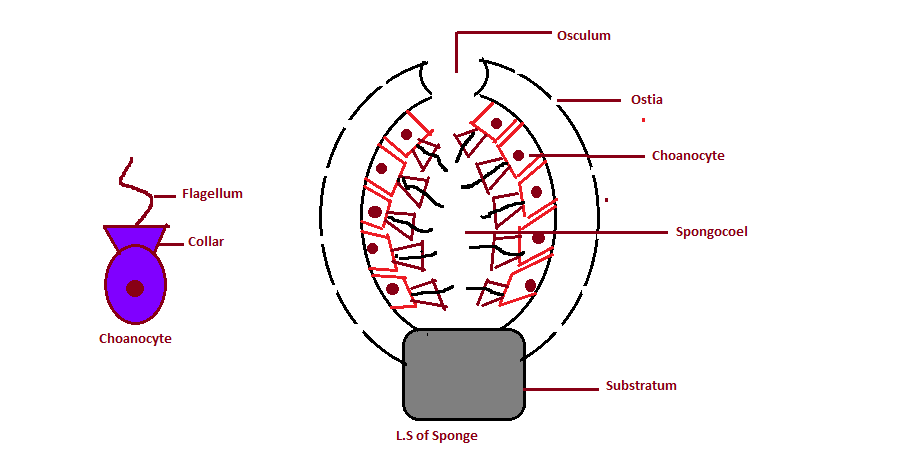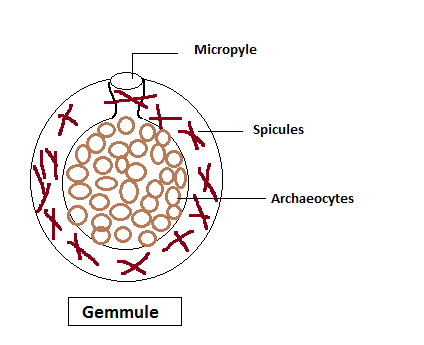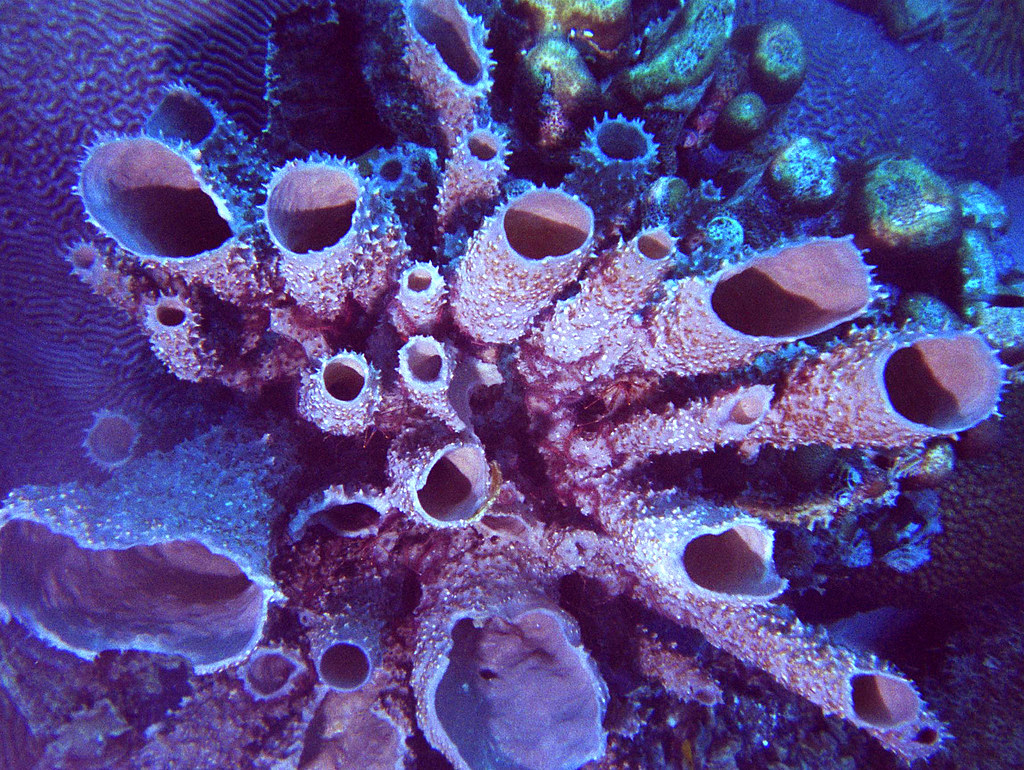Introduction to Phylum Porifera
This is the first phylum of the animal kingdom. The word porifera means “Pore Bearers.” Due to the presence of pores on the sponge, it appears like sponge and thus called sponges. Some of the key features of Porifera are as follows:
- Porifera means pore bearers
- Members of phylum porifera are commonly called as Sponges
- Sponges body consist of many pores called Ostia
- Ostia allows the entry of water into the body
- A large aperture called Osculum allows exit of water from the body
Habit and Habitat of Phylum Porifera
- All sponges are aquatic in nature and that also are mostly marine
- The body of sponges are asymmetrical i.e., you cannot cut sponges in two equal halves from any radius
- Some sponges are also found in fresh water and such sponges are called Spongilla
- Sponges cannot move. They get attached to the rocks or any other objects inside water. Such organisms which cannot move are called Sessile or Sedentary. However, the larvae of sponges are motile because if the larvae are also sessile, they would reproduce at one place and cause overcrowding of the colony. New sponges formed would not be able to reach to other places. And that is why, larvae are motile so that they could reach to new places and form new colonies.
- Sponges are primitive multicellular animals and represent cellular level of organization (no tissue present).
- They are called blind branch of evolutionary tree because they didn’t give rise to any higher phylum.
- Connecting link between Protozoa and Porifera is PROTEROSPONGIA
Body Structure of Phylum Porifera:
Body wall of sponges consists of two layers:
- Outer Pinacoderm
- Inner Choanoderm
In between the outer and the inner layer, a non-cellular jelly-like layer, called Mesenchyma is present. The middle non-cellular layer forms endoskeleton that is made up of either sponges fibre or spicules made up of calcium carbonate or silica.

This mesenchyma holds the outer and the inner layer together. Mesenchyme also consists of a special cell, called amoebocyte, also known as archaeocyte. These cells have the ability to transform into specialized cells. However, body cavity of sponges is called Spongocoel or Paragastric cavity or Atrium.

One of the interesting things associated with sponges is that water enters into the body of sponges through ostia and leave the body through osculum. Since sponges live under water, why cannnot water enter into the sponges body through osculum also? This is because the beating of flagella from choanocytes maintains the water current. Choanocytes line the spongocoel and the canals. So, water moves out through osculum only. If the beating of the choanocytes flagella is stopped, sponges would no longer be alive.
The outer pinacoderm consists of pinacocyte. The former is involved in the formation of pinacoderm whereas the latter is involved in the canal system i.e., the constant flow of water current from inside to the outside of the body.
Gas Exchange:
- All body systems are absent in sponges because they show cellular-level of organization.
- Gas exchange takes place through general body surface by diffusion.
- There are no specialized respiratory structures or organs.
Excretory System:
- Excretion occurs through general body surface.
- Specialized excretory structures or organs are absent.
- Excretory product is ammonia
Note: Sponges are not found in cold water. These flourish best in warm shallow water.
Nutrition:
- Sponges feed on microscopic food particles such as bacteria, diatoms, and protozoans.
- Food is captured by the flagella of choanocytes, which digest it partially.
- Partially digested food is passed on to trophocytes, which digest it completely and distribute it.
- Digestion is intracellular
- The undigested food is thrown out of the body through osculum.
Skeletal System:
- The body is supported by a skeleton made up of spicules or sponging fibres
- Spicules are needle-like structures which could either be calcareous (made up of Calcium carbonate) or siliceous (made up of silica) in nature
Nervous System:
- Sponges lack neurons but they are sensitive to external environment
- Pinacocytes are contractile cells responsible for the sensitivity to the external environment
- These cells can either increase or decrease the overall surface of the sponge body.
Note: Sponges are devoid of sensory and nerve cells. This is the only phylum in the entire animal kingdom that is devoid of the nervous system.
Water Canal System:
Sponges possess water canal system
It is called the lifeline of sponges
Water enters the sponge body through ostia in the body wall and finally into a central cavity, spongocoel from where it goes out through the osculum.
H2O — > Ostia — > Ostia — > Spogocoel — > Osculum
Water canal system helps in food gathering, respiratory exchange, removal of wastes and reproduction.
Reproductive System:
- Sponges are hermaphrodite in nature
- Sexes are not separate
- Both asexual and sexual reproduction are present in sponges
Asexual reproduction by:
- Fragmentation
- Budding (external)
- Branching
- Gemmule formation (internal)

Gemmules are formed internally. In the diagram, a detailed structure of gemmule has been represented. It contains spicules, micropyle (opening) and archaeocytes. These cells are totipotent in nature i.e., they have the ability to form any other cells. These cells possess large nucleus and can adopt different shapes depending on the need of the organism. It is important to mention that gemmule formation takes place during unfavourable condition only.
These gemmules formed internally, reach the spongocoel and come out through osculum. This ball like structure after coming out from the osculum, travel long distances and waits for the favourable condition (ample amount of water). They can remain dormant for many years. However, upon arrival of favourable condition, archaeocytes come out through the micropylar end and germinate into a new sponge body.
Sexual Reproduction in Phylum Porifera
- Hermaphrodite
- Gametes are formed i.e., male (sperm) and female gametes (oocyte or ova)
- Fertilization is internal
- Scypha sponge is Protogynous i.e., ova matures first than the sperm. This is to avoid self-fertilization, as self-fertilization does not lead to producing variation.
- Gametes are produced either by archaeocytes or trophocytes.
- Oocytes once produced remain inside mesoglea and wait for the sperms to fertilize.
- A large number of sperms are released by the sponges through osculum in water and enter the body of another sponge through canal system where chanocytes with their flagella trap them.
- Choanocytes act as nurse cells and thus transport the sperm body without tail to fertilize the mature ova that wait in the mesoglea.
- The sperm nucleus fuses with the ova nucleus and thus internal fertilization takes place.
Fertilization and Development in Phylum Porifera
- Sponges show indirect development having a larval stage (indirect development involves the formation of larva in the life cycle)
- Larvae are ciliated and free swimming
- The different larval stages include amphiblastula, parenchymula and rhagon.
Examples of Phylum Porifera:
- Spongilla (Fresh water sponge)
- Euspongia (common bath sponge)
- Sycon (crown sponge or urn sponge)
- Cliona (Boring sponge or sulphur sponge) – produces sulphuric acid that is harmful for pearls as it forms pores on the wall of the pearl producing oysters.
Phylum Porifera Video by Dr. Sachin Kapur Sir – NEET Exam

